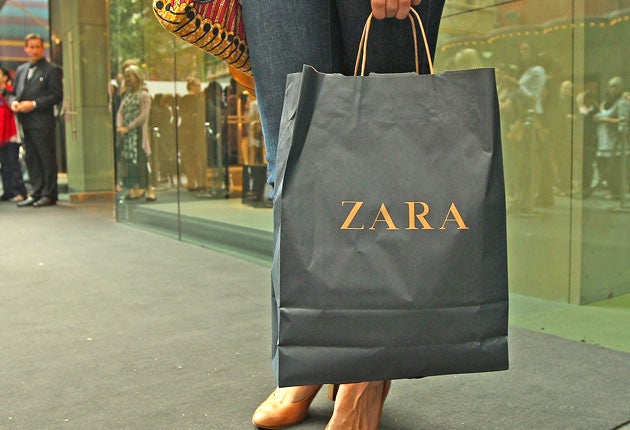New Zara boss plots more of the same
The world's biggest fashion retailer has a seemless succession strategy and won't change a winning formula, says James Thompson

It is the end of an era at Inditex, the Spanish company behind the Zara and Massimo Dutti clothing chains, with founder and chairman Amancio Ortega due to finally step down after its annual meeting next month.
The handing over of the reins to Pablo Isla, the current chief executive and deputy chairman, will shine the spotlight on Inditex, the business that Mr Ortega – now Spain's richest man – has built into the world's largest clothing retailer by sales volumes. However, industry experts do not expect wholesale changes to the strategy that has seen it grow into a retail colossus with 5,154 shops in 78 countries.
After all, Mr Isla has already been chief executive for six years and Inditex – which the founder began as a textile manufacturing operation in 1963 – continues to power ahead. The group, whose other brands include Pull and Bear, Bershka and Oysho, grew profits by 10 per cent to €332m (£294m) in the quarter to 30 April.
"It is a pretty strong entrenched culture that the current chief executive will carry on," says Maureen Hinton, a senior analyst at Verdict Research, the retail consultancy. "It has a very strong growth proposition globally." One quite sees that: in a further sign of its power, Inditex's market capitalisation, at $55.4bn, has this week moved ahead of its Swedish rival H&M to make it the world's biggest clothing retailer.
Despite its momentum, Mr Isla will face a number of challenges in his first year in charge as chief excutive and chairman. These include subdued consumer spending inEurope, rising raw materials and supply chain costs, and the logistics of fashion lines designed for the different weather seasons of the southern hemisphere. Inditex also plans to launch an as yet unnamed new shoe and accessories brand in September at its headquarters in Galicia, northern Spain.
Isabel Cavill, a senior retail analyst at Planet Retail, believes the new brand will be "significant". "In the past, when they have launched a new brand they have tended to introduce it into every market," she explains:
The introduction of a dedicated shoes and accessories brand will enable Inditex to compete more aggressively with its rivals, such as Accessorize, Kurt Geiger and other high-street footwear specialists in Europe, as well as the Collective Brands group overseas.
Another strand of its ongoing strategy that could be tough for Inditex to implement will be delivering different ranges for its stores in the southern hemisphere. Inditex is apioneer in this field, as no other northern hemisphere retailer has yet been able to overcome the difficulty of producing winter ranges at the same time as summer ones. Inditex has average lead times of two to three weeks – delivering products from initial concept to shop floor – and a key driver of this is that it owns 11 giant factories in its Arteixo, its heartland in northern Spain.
A spokesman for Inditex says: "Proximity production is a key element in our business model."
In fact, Inditex produces about 50 per cent of its products in Spain,Portugal and Morocco, while it does very little manufacturing in Asia – unlike the model used by many British and international retailers.
Ms Cavill adds: "The lead times in the southern hemisphere will be key. I think it could be a challenge for them to produce products as fast as they have, in different parts of the world. Where they really win is through their short lead times." This is partly due the sheer scale of continents, such as South America and Australia.
Then there is the subdued consumer spending environment across its Europe, whichaccounted for 45 per cent of group sales in 2010. Ms Hinton says: "The European markets are very competitive and the consumer is under pressure." However, so far, Inditex does not appear to have lost any momentum. While its revenues were aided by 110 new stores globally, the group grew sales by 11 per cent to €2.96bn in the three months to the end of April.
Indeed, Mr Isla's main challenge – as it has been since 2005 – will be to keep sprinkling the magic dust that Mr Ortega has since Inditex itself was established in 1985. For instance, the firm is known for avoiding advertising, which helps the bottom line.
In other areas, its success has been driven by a policy of non-collaboration with designers, relyinginstead on its 1,000-strong team in design and product development.
While Mr Isla works on Inditex's strong pushes into emerging markets in Asia and South America – as well as e-commerce in many countries – he will know the group will be judged on how it responds to customers. As Ms Hinton says: "It is their flexibility that helps make them so successful."
The path to dominance
*1963: Amancio Ortega, the founder of Inditex, starts his career as a textile maker. Over the next decade, he builds it up to several factories selling clothes to Europe.
*1975: The first Zara store opens in La Coruña, Spain.
*1985: Inditex is founded as the holding company of the group of businesses operating at the time.
*1991: The Pull & Bear chain is founded, and Inditex buys 65 per cent of menswear chain Massimo Dutti.
*2001: Inditex is floated on the stock market in Spain.
*2010: Opens stores in India after signing a joint venture with Tata Group.
Subscribe to Independent Premium to bookmark this article
Want to bookmark your favourite articles and stories to read or reference later? Start your Independent Premium subscription today.

Join our commenting forum
Join thought-provoking conversations, follow other Independent readers and see their replies